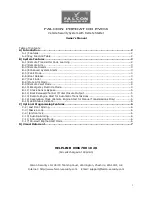
10. GENERAL CARBON MONOXIDE (CO) INFORMATION
Carbon monoxide (CO) is a colorless, odorless, and tasteless poison gas that can
be fatal when inhaled. CO inhibits the blood's capacity to carry oxygen.
POSSIBLE SOURCES OF CARBON MONOXIDE
Inside your home, appliances used for heating and cooking are the most likely
sources of CO. Vehicles running in attached garages can also produce danger-
ous levels of CO.
CO can be produced when burning any fossil fuel: gasoline, propane, natural
gas, oil and wood. It can be produced by any fuel-burning appliance that is mal-
functioning, improperly installed, or not ventilated correctly, such as:
Possible sources include furnaces, gas ranges/stoves, gas clothes dryers, water
heaters, portable fuel burning space heaters, fireplaces, wood-burning stoves
and certain swimming pool heaters. Blocked chimneys or flues, back drafting
and changes in air pressure, corroded or disconnected vent pipes, or a loose or
cracked furnace exchanger can also release CO into your building. Vehicles and
other combustion engines running in an attached garage and using a charcoal/
gas grill or hibachi in an enclosed area are all possible sources of CO.
The following conditions can result in transient CO situations:
Excessive spillage or reverse venting of fuel-burning appliances caused by
outdoor ambient conditions such as:Wind direction and/or velocity, including
high gusts of wind, heavy air in the vent pipes (cold/humid air with extended
periods between cycles), negative pressure differential resulting from the use of
exhaust fans, simultaneous operation of several fuel-burning appliances
competing for limited internal air, vent pipe connections vibrating loose from
clothes dryers, furnaces, or water heaters, obstructions in, or unconventional,
vent pipe designs which can amplify the above situations, extended operation of
unvented fuel-burning devices (range, oven, fireplace, etc.), temperature inver-
sions which can trap exhaust gasses near the ground, car idling in an open or
closed attached garage, or near a home.
CO SAFETY TIPS
Every year, have the heating system, vents, chimney and flue inspected and
cleaned by a qualified technician. Always install appliances according to manu-
facturer’s instructions and adhere to local building codes. Most appliances
should be installed by professionals and inspected after installation. Regularly
examine vents and chimneys for improper connections, visible rust, or stains,
and check for cracks in furnace heat exchangers. Verify that the color of flame
is blue on pilot lights and burners. A yellow or orange flame is a sign that the fuel







































